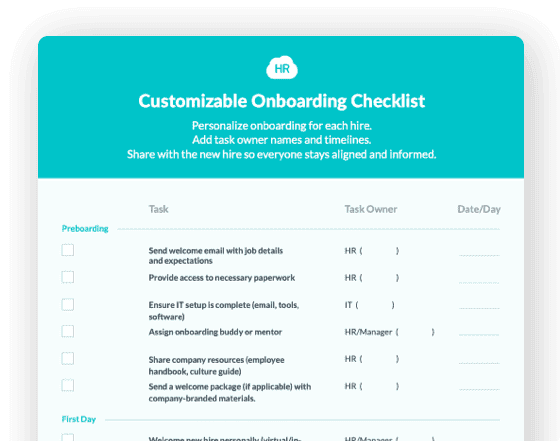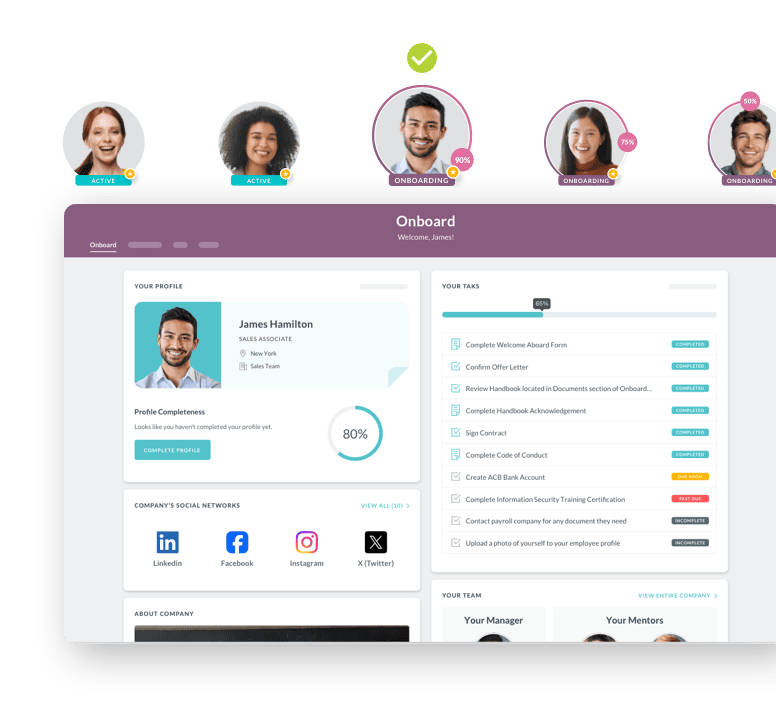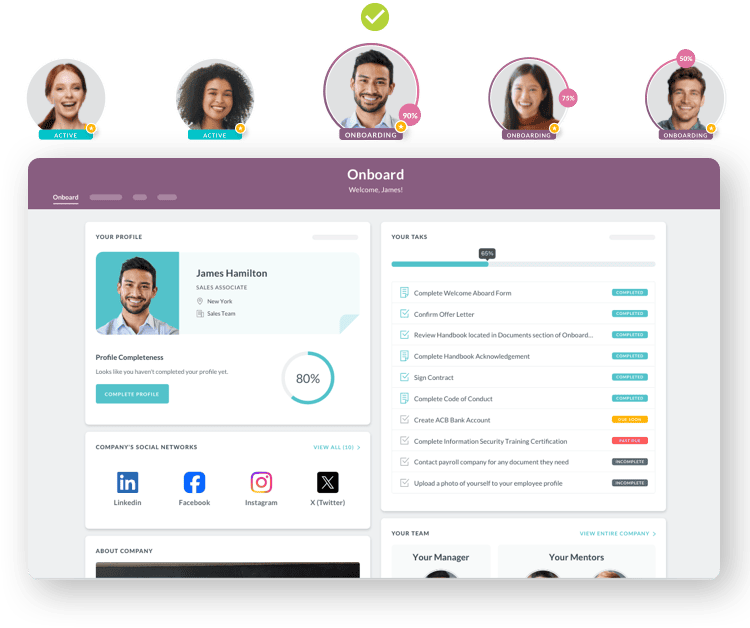147c Letter Request
- Why Your Business Needs EIN Verification Documentation
- 147c Letter vs. Other Tax Documents: Understanding the Differences
- Best Practices for Managing Your 147c Letter Request
- Common Pitfalls to Avoid When Requesting Your 147c Letter
- Industry Applications: How Different Sectors Use 147c Letters
- Your Step-by-Step Implementation Plan for Requesting a 147c Letter
- Future Outlook: Digital Transformation in Tax Verification

 Cut onboarding time
by 60%—here's the
Ultimate Checklist
that helped do it.
Cut onboarding time
by 60%—here's the
Ultimate Checklist
that helped do it.

Every business operating in the United States needs an Employer Identification Number, or EIN. This nine-digit number works like a Social Security number for your company. It helps the IRS track your tax obligations and identify your business in official transactions. But what happens when you lose the paperwork that confirms your EIN? That's where the 147c letter request comes in.
A 147c letter is an official IRS document that verifies your business's existing EIN. Think of it as a replacement confirmation letter. The IRS issues this letter when you need proof of your EIN but can't locate your original CP 575 notice, which is the first confirmation letter the IRS sends when you apply for an EIN. Business owners and HR professionals often need this letter for banking, compliance, and vendor relationships.
Understanding how to request and use a 147c letter is essential for smooth business operations. When you're opening a bank account, applying for a business loan, or setting up payroll systems, financial institutions will ask for documented proof of your EIN. Without this verification, basic business activities grind to a halt. HR teams that handle employee onboarding software and new hire paperwork especially need to understand this process, as it affects how quickly you can bring new team members on board and get them into your payroll system.
The 147c letter request process might seem like a small administrative task. But it represents a larger truth about business operations. Documentation matters. When your paperwork is organized and accessible, you avoid costly delays and compliance issues. Let's explore everything you need to know about requesting, using, and managing your 147c letter.
Why Your Business Needs EIN Verification Documentation
Your EIN verification serves multiple critical functions in your business operations. Here are the key reasons why this documentation matters:
Banking Relationships Require Proof:
Banks and credit unions need verified EIN documentation before opening business accounts or processing loan applications. They use this to confirm your business identity and ensure they're working with a legitimate entity registered with the IRS.
Payroll Setup Depends on it:
You cannot establish payroll systems without proper EIN verification. Payroll providers need this confirmation to ensure they're reporting taxes correctly and withholding the right amounts for the proper business entity.
Vendor Relationships Demand Verification:
Many vendors and partners require EIN confirmation before entering into business relationships. This protects them from fraud and ensures proper tax reporting on their end.
HR Compliance Requires Accurate Records:
Maintaining proper documentation is part of your overall compliance strategy. Having your EIN readily available helps you meet regulatory requirements and pass audits.
License Applications Need Documentation:
State and local licensing agencies often require EIN verification as part of their application process. Without it, you cannot obtain the permits necessary to operate legally.
Credit Card Processing Systems Require it:
If you accept credit card payments, processors need your EIN to set up merchant accounts and ensure proper financial reporting.
147c Letter vs. Other Tax Documents: Understanding the Differences
|
Document Type |
Purpose |
When Issued |
How to Obtain |
|
CP 575 Notice |
Original EIN confirmation |
Immediately after EIN application |
Automatically sent by IRS |
|
147c Letter |
Replacement EIN verification |
When original is lost |
Phone request to IRS only |
|
Employee tax withholding |
At hire or life changes |
Employee completes directly |
|
|
SS-4 Application |
Initial EIN application |
Before EIN assignment |
Completed by business owner |
Best Practices for Managing Your 147c Letter Request
Successfully managing your EIN verification starts with preparation and organization. Here's how to handle the process effectively:
Before you pick up the phone to call the IRS, gather all relevant business information. You'll need your business legal name exactly as it appears on your SS-4 application. You'll also need your business address, the responsible party's name and Social Security number, and the approximate date when your business was formed. Having this information ready speeds up the verification process significantly.
Choose the right time to call the IRS Business and Specialty Tax Line at 1-800-829-4933. The best times are typically early morning between 7:00 AM and 10:00 AM, or late afternoon between 3:00 PM and 7:00 PM local time. Avoid calling on Mondays, which tend to be the busiest day of the week. According to guidance from the IRS, patience during peak times is essential.
Designate an authorized representative to make the call. The IRS will only share your EIN with someone who is authorized to receive it. This includes business owners, corporate officers, partners, or someone with power of attorney documentation. If you need a third party to handle this request, complete Form 2848 beforehand to establish their authority.
Create a secure storage system for your 147c letter once you receive it. Make multiple copies and store them in different locations. Keep one copy in your physical files, save a digital copy in your secure cloud storage, and provide a copy to your accounting department or bookkeeper. This redundancy ensures you'll always have access when needed, especially during essential onboarding documents processing.
Document the request in your employee records system. Note when you requested the letter, who made the request, and when you received it. This creates an audit trail that proves your diligence in maintaining proper documentation.
Set up a system for annual review of all tax identification documents. Include your 147c letter in this review to ensure all information remains current and accessible. This proactive approach prevents scrambling for documents during critical business transactions.


Common Pitfalls to Avoid When Requesting Your 147c Letter
Many businesses make preventable mistakes when requesting their 147c letter. Understanding these pitfalls helps you avoid unnecessary delays and frustration.
Requesting through the wrong channel ranks as the most common error. The IRS does not accept 147c letter requests by email, online form, or fax for initial requests. You must call the Business and Specialty Tax Line directly. While you can request the letter be faxed to you after the phone verification, the initial request requires a phone call. Security concerns drive this policy.
Providing incorrect business information during the verification process causes immediate problems. If your business name, address, or responsible party information doesn't match IRS records, they cannot verify your identity and release your EIN. Double-check everything before calling. Minor discrepancies like "Inc." versus "Incorporated" can create issues.
Waiting until you need the letter urgently creates unnecessary stress. If you choose mail delivery instead of fax, the letter can take four to six weeks to arrive. This delay can derail time-sensitive transactions like bank account openings or loan applications. Plan ahead and request your letter before you need it.
Failing to confirm fax reception causes problems. If you choose to have the IRS fax your 147c letter, stay on the line to confirm they sent it successfully and that you received it. Technical issues with fax machines can prevent successful transmission. Don't hang up until you verify you have the document.
Not maintaining proper security for your EIN information exposes your business to risk. While the IRS will only release your EIN to authorized individuals, you must also protect the 147c letter once you receive it. Store it securely and limit access to only those who need it for legitimate business purposes.
Industry Applications: How Different Sectors Use 147c Letters
The 147c letter serves businesses across all industries, though specific applications vary by sector. Understanding these real-world uses helps clarify why this documentation matters.
Healthcare providers need their 147c letters frequently. Medical practices opening new locations require EIN verification for state licensing boards, medical billing systems, and relationships with insurance companies. A dental practice expanding to a second office, for example, needs to provide EIN verification to establish merchant accounts for patient payments and to set up relationships with dental supply vendors. The new hire paperwork for medical staff also requires proper EIN documentation for background checks and licensing verification.
Technology startups use 147c letters in their growth phases. When a software company seeks venture capital funding, investors require verified EIN documentation as part of their due diligence process. The startup must prove it exists as a legitimate business entity registered with the IRS. Similarly, when these companies integrate with payment processors to monetize their products, the processors demand EIN verification before enabling transactions.
Retail businesses need 147c letters for various operational requirements. A boutique opening a second location needs EIN verification to establish a business bank account in the new area, to apply for a retail sales permit from the state, and to set up credit card processing for the new store location. Research from the World Economic Forum shows that proper documentation streamlines expansion and reduces regulatory friction.
Your Step-by-Step Implementation Plan for Requesting a 147c Letter
Follow this structured approach to successfully request and receive your 147c letter.
Step 1: Conduct a Preliminary Search.
Before contacting the IRS, check if you can locate your original CP 575 notice. Search through your business formation documents, old tax returns, business loan applications, and bank account opening paperwork. Check with your accountant or bookkeeper, who may have copies in their files. If you used an online service to apply for your EIN, check your email archives for the confirmation.
Step 2: Gather Required Verification Information.
Compile your business legal name exactly as registered, your current business address, the responsible party's full name and Social Security number, your business structure type, and the approximate date you formed the business. Have your business formation documents nearby in case the IRS agent asks additional questions.
Step 3: Identify your Authorized Representative.
Determine who will make the call to the IRS. This person must be authorized to receive the EIN information. If using someone outside your organization, complete and file Form 2848 with the IRS before making the request.
Step 4: Call During Optimal Times.
Dial 1-800-829-4933 during low-traffic hours. When the automated system answers, press 1 for English, then 1 again for Employer Identification Numbers, then 3 for existing EIN inquiries. Be prepared for potential hold times.
Step 5: Complete the Verification Process.
Answer all security questions accurately. The IRS agent will verify your identity and business information before releasing your EIN or sending a 147c letter. Choose your delivery method—immediate fax or standard mail delivery.
Step 6: Secure and Distribute the Letter.
Once you receive your 147c letter, immediately make multiple copies. Store the original in a secure location, create digital backups, and provide copies to necessary parties like your accounting team, HR department, and bookkeeper.
Step 7: Update your Documentation System.
Record this transaction in your employee self-service onboarding system or HR records. Note the date of request, who made the request, when you received the letter, and where copies are stored. This creates accountability and prevents future confusion.
Future Outlook: Digital Transformation in Tax Verification
The landscape of tax identification and verification continues to evolve with technology. Understanding upcoming trends helps you prepare for changes that affect how you manage your business documentation.
Digital verification systems are becoming more sophisticated. The IRS continues expanding its online services, though security concerns currently limit 147c letter requests to phone-based verification. Future systems may incorporate blockchain technology for secure, instant verification of business tax identification numbers. This would eliminate wait times and reduce the administrative burden on both businesses and the IRS.
Artificial intelligence will play a growing role in document management. Advanced HR systems will automatically flag when tax identification documents need renewal or updating. These systems will integrate with IRS databases to verify EIN information in real time, reducing the need for manual verification processes. Companies investing in modern HR technology platforms position themselves to take advantage of these advances.
Mobile-first solutions are emerging for business documentation. As more business activities move to smartphones and tablets, expect to see mobile apps that securely store and share tax identification documents. Biometric authentication will add another layer of security to accessing sensitive business information.
Regulatory compliance is becoming more automated. Future systems will automatically cross-reference your EIN across multiple government agencies, alerting you to any discrepancies or issues. This proactive approach helps businesses stay ahead of compliance problems rather than reacting to them after they occur.
The trend toward instant verification will accelerate. Businesses demand faster processes, and government agencies are responding with improved systems. While the 147c letter may always require some form of identity verification for security, the turnaround time will decrease significantly. Prepare your business by maintaining accurate, up-to-date records that facilitate quick verification when needed.
Embracing these technological advances requires investment in proper systems and training. Companies that digitize their document management now will transition more smoothly to future innovations. The key is balancing security with accessibility, ensuring that authorized personnel can access critical documents like your 147c letter quickly while maintaining robust protection against unauthorized access.
Your 147c letter represents more than just a piece of paper from the IRS. It's proof of your business's legitimacy and a key that unlocks essential business functions. By understanding how to request, manage, and use this document effectively, you position your business for smooth operations and regulatory compliance. Take the time to request your 147c letter before you need it urgently, store it securely, and integrate it into your overall document management strategy. These small steps today prevent major headaches tomorrow.
Keep Reading
Credential Tracking in Healthcare: How to Automate License Renewals and Stay Audit-Ready
A nurse shows up ready for her shift but her license expired yesterday. You scramble for
Onboarding 500 Nurses a Year: Lessons from High-Volume Hospital HR Teams
Hiring 5 nurses can be done off-the-cuff. But hiring 500 is a logistics operation by
AI for Frontline HR: Moving Beyond Sentiment Analysis to Build Tomorrow's Workforce Management Engine
TL;DR: While most organizations limit artificial intelligence in human resources to basic
Ready to streamline your onboarding process?
Book a demo today and see how HR Cloud can help you create an exceptional experience for your new employees.







